HRM Practices: Impact on Profit, Productivity & Employee Relations
VerifiedAdded on 2023/06/12
|19
|5506
|58
Report
AI Summary
This report provides a comprehensive analysis of human resource management (HRM) practices, employee relations, and employment legislation within an organizational context, specifically focusing on Sainsbury. It explores the purpose and functions of HRM, including job analysis, hiring, training, compensation, and benefits, highlighting their impact on manpower planning. The report evaluates various approaches to recruitment and selection, weighing their advantages and disadvantages. It also examines the benefits of different HRM practices for both employers and employees, assessing their effectiveness in boosting organizational profit and productivity. Furthermore, the report delves into the importance of employee relations in influencing HRM decision-making and identifies key elements of employment legislation, analyzing their impact on HRM decisions. The analysis includes an evaluation of employee relations management and the application of HRM practices that inform and influence decision-making, concluding with a critical evaluation of these aspects in the context of Sainsbury.
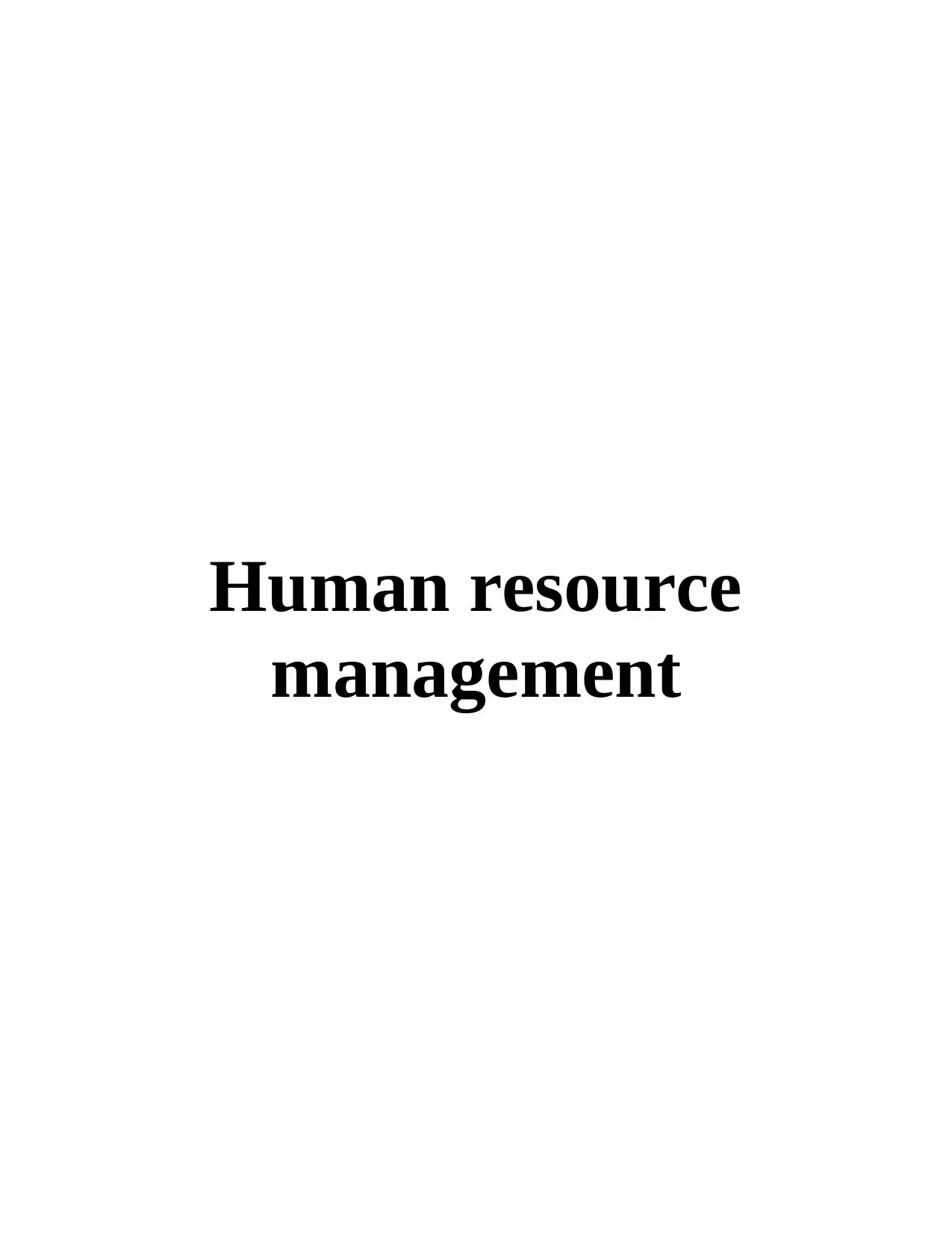
Human resource
management
management
Paraphrase This Document
Need a fresh take? Get an instant paraphrase of this document with our AI Paraphraser
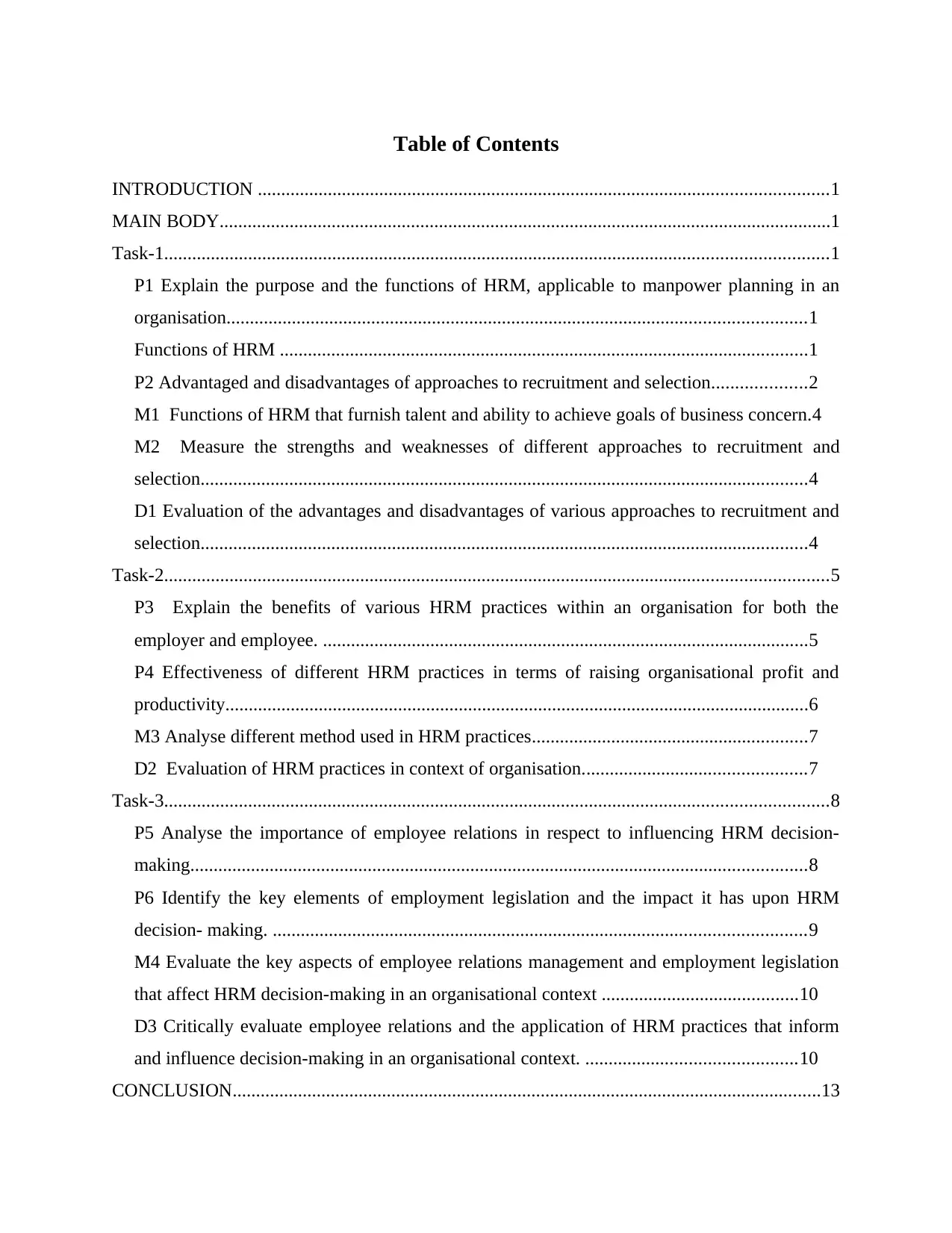
Table of Contents
INTRODUCTION ..........................................................................................................................1
MAIN BODY...................................................................................................................................1
Task-1..............................................................................................................................................1
P1 Explain the purpose and the functions of HRM, applicable to manpower planning in an
organisation............................................................................................................................1
Functions of HRM .................................................................................................................1
P2 Advantaged and disadvantages of approaches to recruitment and selection....................2
M1 Functions of HRM that furnish talent and ability to achieve goals of business concern.4
M2 Measure the strengths and weaknesses of different approaches to recruitment and
selection..................................................................................................................................4
D1 Evaluation of the advantages and disadvantages of various approaches to recruitment and
selection..................................................................................................................................4
Task-2..............................................................................................................................................5
P3 Explain the benefits of various HRM practices within an organisation for both the
employer and employee. ........................................................................................................5
P4 Effectiveness of different HRM practices in terms of raising organisational profit and
productivity.............................................................................................................................6
M3 Analyse different method used in HRM practices...........................................................7
D2 Evaluation of HRM practices in context of organisation................................................7
Task-3..............................................................................................................................................8
P5 Analyse the importance of employee relations in respect to influencing HRM decision-
making....................................................................................................................................8
P6 Identify the key elements of employment legislation and the impact it has upon HRM
decision- making. ..................................................................................................................9
M4 Evaluate the key aspects of employee relations management and employment legislation
that affect HRM decision-making in an organisational context ..........................................10
D3 Critically evaluate employee relations and the application of HRM practices that inform
and influence decision-making in an organisational context. .............................................10
CONCLUSION..............................................................................................................................13
INTRODUCTION ..........................................................................................................................1
MAIN BODY...................................................................................................................................1
Task-1..............................................................................................................................................1
P1 Explain the purpose and the functions of HRM, applicable to manpower planning in an
organisation............................................................................................................................1
Functions of HRM .................................................................................................................1
P2 Advantaged and disadvantages of approaches to recruitment and selection....................2
M1 Functions of HRM that furnish talent and ability to achieve goals of business concern.4
M2 Measure the strengths and weaknesses of different approaches to recruitment and
selection..................................................................................................................................4
D1 Evaluation of the advantages and disadvantages of various approaches to recruitment and
selection..................................................................................................................................4
Task-2..............................................................................................................................................5
P3 Explain the benefits of various HRM practices within an organisation for both the
employer and employee. ........................................................................................................5
P4 Effectiveness of different HRM practices in terms of raising organisational profit and
productivity.............................................................................................................................6
M3 Analyse different method used in HRM practices...........................................................7
D2 Evaluation of HRM practices in context of organisation................................................7
Task-3..............................................................................................................................................8
P5 Analyse the importance of employee relations in respect to influencing HRM decision-
making....................................................................................................................................8
P6 Identify the key elements of employment legislation and the impact it has upon HRM
decision- making. ..................................................................................................................9
M4 Evaluate the key aspects of employee relations management and employment legislation
that affect HRM decision-making in an organisational context ..........................................10
D3 Critically evaluate employee relations and the application of HRM practices that inform
and influence decision-making in an organisational context. .............................................10
CONCLUSION..............................................................................................................................13

REFERENCES .............................................................................................................................14
⊘ This is a preview!⊘
Do you want full access?
Subscribe today to unlock all pages.

Trusted by 1+ million students worldwide
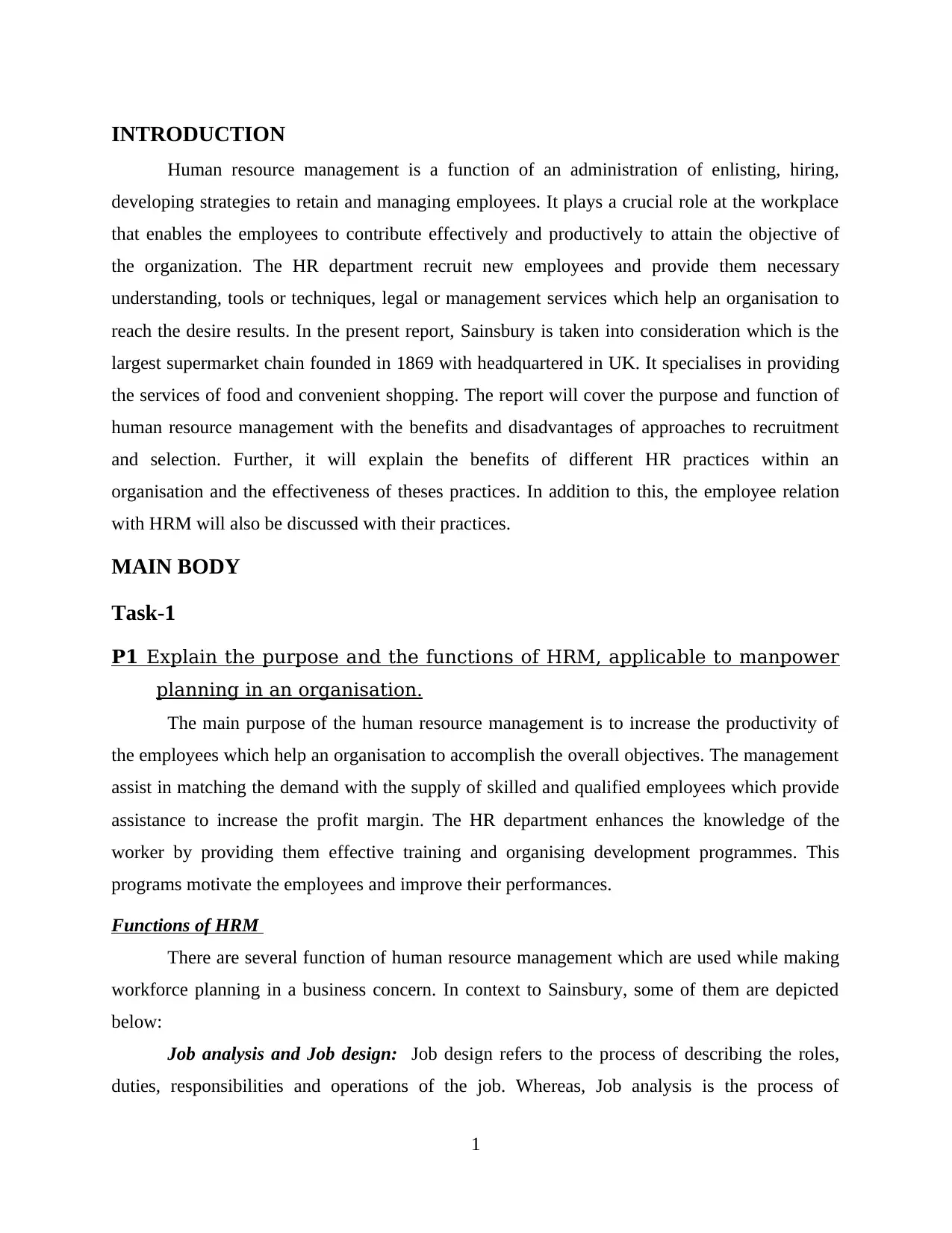
INTRODUCTION
Human resource management is a function of an administration of enlisting, hiring,
developing strategies to retain and managing employees. It plays a crucial role at the workplace
that enables the employees to contribute effectively and productively to attain the objective of
the organization. The HR department recruit new employees and provide them necessary
understanding, tools or techniques, legal or management services which help an organisation to
reach the desire results. In the present report, Sainsbury is taken into consideration which is the
largest supermarket chain founded in 1869 with headquartered in UK. It specialises in providing
the services of food and convenient shopping. The report will cover the purpose and function of
human resource management with the benefits and disadvantages of approaches to recruitment
and selection. Further, it will explain the benefits of different HR practices within an
organisation and the effectiveness of theses practices. In addition to this, the employee relation
with HRM will also be discussed with their practices.
MAIN BODY
Task-1
P1 Explain the purpose and the functions of HRM, applicable to manpower
planning in an organisation.
The main purpose of the human resource management is to increase the productivity of
the employees which help an organisation to accomplish the overall objectives. The management
assist in matching the demand with the supply of skilled and qualified employees which provide
assistance to increase the profit margin. The HR department enhances the knowledge of the
worker by providing them effective training and organising development programmes. This
programs motivate the employees and improve their performances.
Functions of HRM
There are several function of human resource management which are used while making
workforce planning in a business concern. In context to Sainsbury, some of them are depicted
below:
Job analysis and Job design: Job design refers to the process of describing the roles,
duties, responsibilities and operations of the job. Whereas, Job analysis is the process of
1
Human resource management is a function of an administration of enlisting, hiring,
developing strategies to retain and managing employees. It plays a crucial role at the workplace
that enables the employees to contribute effectively and productively to attain the objective of
the organization. The HR department recruit new employees and provide them necessary
understanding, tools or techniques, legal or management services which help an organisation to
reach the desire results. In the present report, Sainsbury is taken into consideration which is the
largest supermarket chain founded in 1869 with headquartered in UK. It specialises in providing
the services of food and convenient shopping. The report will cover the purpose and function of
human resource management with the benefits and disadvantages of approaches to recruitment
and selection. Further, it will explain the benefits of different HR practices within an
organisation and the effectiveness of theses practices. In addition to this, the employee relation
with HRM will also be discussed with their practices.
MAIN BODY
Task-1
P1 Explain the purpose and the functions of HRM, applicable to manpower
planning in an organisation.
The main purpose of the human resource management is to increase the productivity of
the employees which help an organisation to accomplish the overall objectives. The management
assist in matching the demand with the supply of skilled and qualified employees which provide
assistance to increase the profit margin. The HR department enhances the knowledge of the
worker by providing them effective training and organising development programmes. This
programs motivate the employees and improve their performances.
Functions of HRM
There are several function of human resource management which are used while making
workforce planning in a business concern. In context to Sainsbury, some of them are depicted
below:
Job analysis and Job design: Job design refers to the process of describing the roles,
duties, responsibilities and operations of the job. Whereas, Job analysis is the process of
1
Paraphrase This Document
Need a fresh take? Get an instant paraphrase of this document with our AI Paraphraser
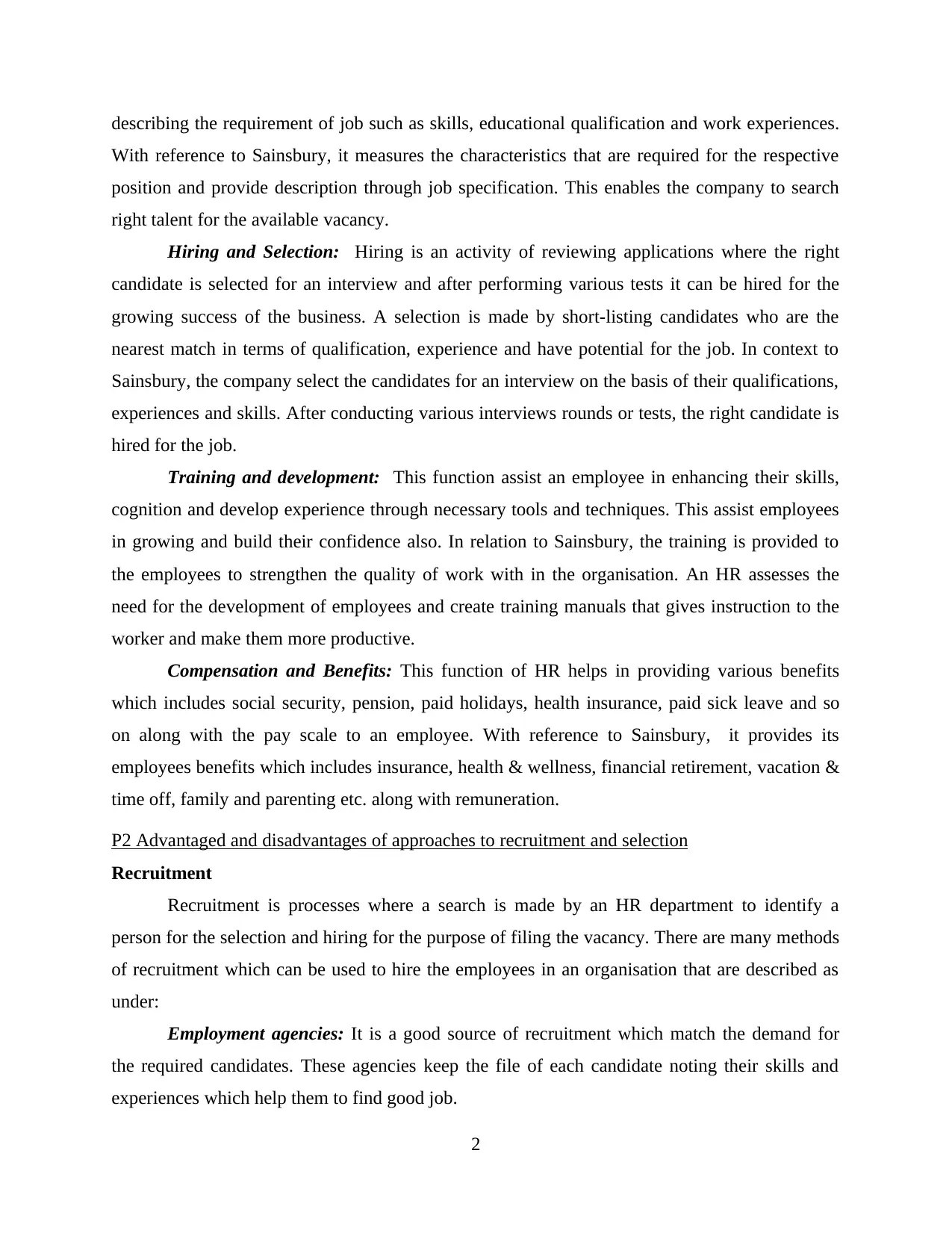
describing the requirement of job such as skills, educational qualification and work experiences.
With reference to Sainsbury, it measures the characteristics that are required for the respective
position and provide description through job specification. This enables the company to search
right talent for the available vacancy.
Hiring and Selection: Hiring is an activity of reviewing applications where the right
candidate is selected for an interview and after performing various tests it can be hired for the
growing success of the business. A selection is made by short-listing candidates who are the
nearest match in terms of qualification, experience and have potential for the job. In context to
Sainsbury, the company select the candidates for an interview on the basis of their qualifications,
experiences and skills. After conducting various interviews rounds or tests, the right candidate is
hired for the job.
Training and development: This function assist an employee in enhancing their skills,
cognition and develop experience through necessary tools and techniques. This assist employees
in growing and build their confidence also. In relation to Sainsbury, the training is provided to
the employees to strengthen the quality of work with in the organisation. An HR assesses the
need for the development of employees and create training manuals that gives instruction to the
worker and make them more productive.
Compensation and Benefits: This function of HR helps in providing various benefits
which includes social security, pension, paid holidays, health insurance, paid sick leave and so
on along with the pay scale to an employee. With reference to Sainsbury, it provides its
employees benefits which includes insurance, health & wellness, financial retirement, vacation &
time off, family and parenting etc. along with remuneration.
P2 Advantaged and disadvantages of approaches to recruitment and selection
Recruitment
Recruitment is processes where a search is made by an HR department to identify a
person for the selection and hiring for the purpose of filing the vacancy. There are many methods
of recruitment which can be used to hire the employees in an organisation that are described as
under:
Employment agencies: It is a good source of recruitment which match the demand for
the required candidates. These agencies keep the file of each candidate noting their skills and
experiences which help them to find good job.
2
With reference to Sainsbury, it measures the characteristics that are required for the respective
position and provide description through job specification. This enables the company to search
right talent for the available vacancy.
Hiring and Selection: Hiring is an activity of reviewing applications where the right
candidate is selected for an interview and after performing various tests it can be hired for the
growing success of the business. A selection is made by short-listing candidates who are the
nearest match in terms of qualification, experience and have potential for the job. In context to
Sainsbury, the company select the candidates for an interview on the basis of their qualifications,
experiences and skills. After conducting various interviews rounds or tests, the right candidate is
hired for the job.
Training and development: This function assist an employee in enhancing their skills,
cognition and develop experience through necessary tools and techniques. This assist employees
in growing and build their confidence also. In relation to Sainsbury, the training is provided to
the employees to strengthen the quality of work with in the organisation. An HR assesses the
need for the development of employees and create training manuals that gives instruction to the
worker and make them more productive.
Compensation and Benefits: This function of HR helps in providing various benefits
which includes social security, pension, paid holidays, health insurance, paid sick leave and so
on along with the pay scale to an employee. With reference to Sainsbury, it provides its
employees benefits which includes insurance, health & wellness, financial retirement, vacation &
time off, family and parenting etc. along with remuneration.
P2 Advantaged and disadvantages of approaches to recruitment and selection
Recruitment
Recruitment is processes where a search is made by an HR department to identify a
person for the selection and hiring for the purpose of filing the vacancy. There are many methods
of recruitment which can be used to hire the employees in an organisation that are described as
under:
Employment agencies: It is a good source of recruitment which match the demand for
the required candidates. These agencies keep the file of each candidate noting their skills and
experiences which help them to find good job.
2
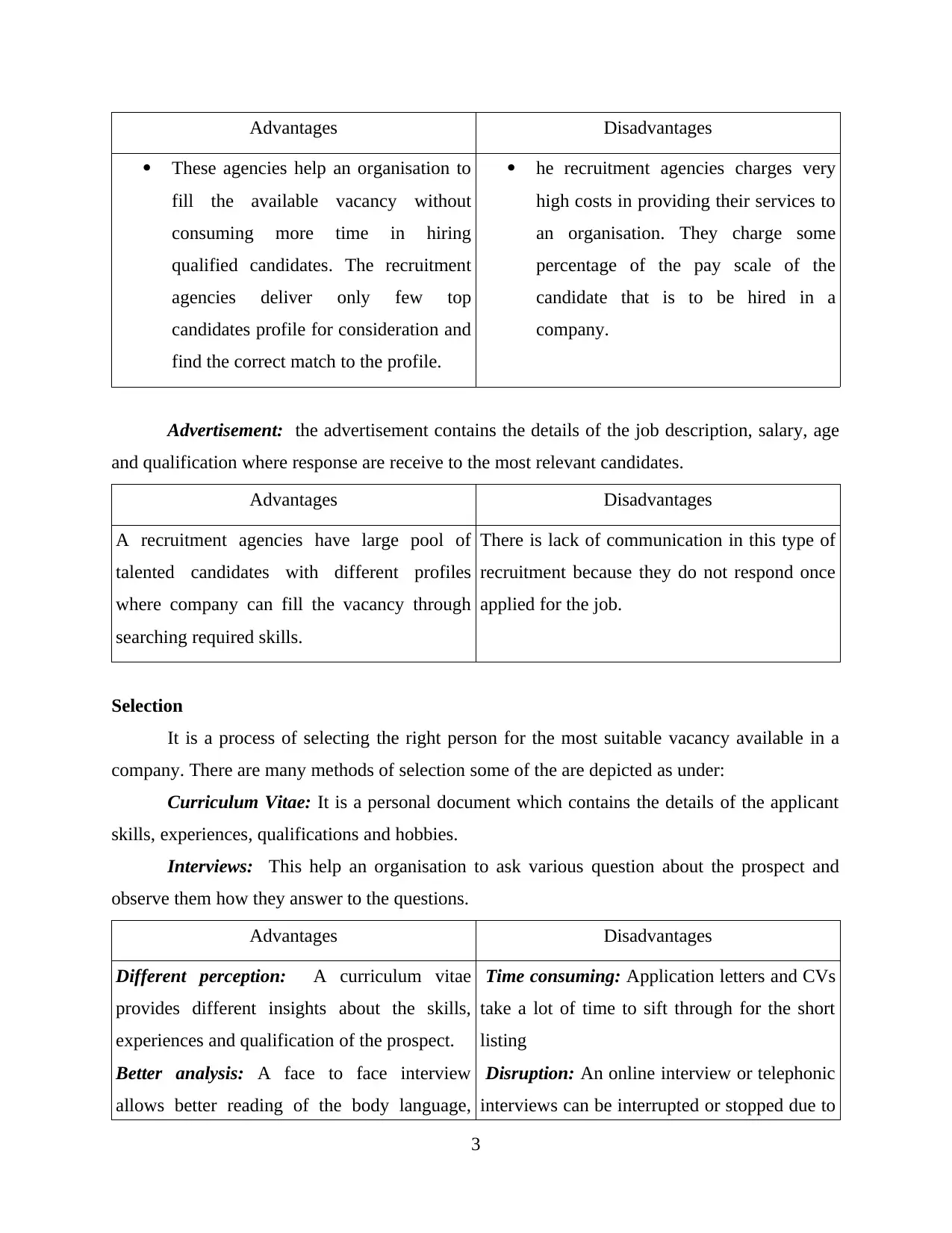
Advantages Disadvantages
These agencies help an organisation to
fill the available vacancy without
consuming more time in hiring
qualified candidates. The recruitment
agencies deliver only few top
candidates profile for consideration and
find the correct match to the profile.
he recruitment agencies charges very
high costs in providing their services to
an organisation. They charge some
percentage of the pay scale of the
candidate that is to be hired in a
company.
Advertisement: the advertisement contains the details of the job description, salary, age
and qualification where response are receive to the most relevant candidates.
Advantages Disadvantages
A recruitment agencies have large pool of
talented candidates with different profiles
where company can fill the vacancy through
searching required skills.
There is lack of communication in this type of
recruitment because they do not respond once
applied for the job.
Selection
It is a process of selecting the right person for the most suitable vacancy available in a
company. There are many methods of selection some of the are depicted as under:
Curriculum Vitae: It is a personal document which contains the details of the applicant
skills, experiences, qualifications and hobbies.
Interviews: This help an organisation to ask various question about the prospect and
observe them how they answer to the questions.
Advantages Disadvantages
Different perception: A curriculum vitae
provides different insights about the skills,
experiences and qualification of the prospect.
Better analysis: A face to face interview
allows better reading of the body language,
Time consuming: Application letters and CVs
take a lot of time to sift through for the short
listing
Disruption: An online interview or telephonic
interviews can be interrupted or stopped due to
3
These agencies help an organisation to
fill the available vacancy without
consuming more time in hiring
qualified candidates. The recruitment
agencies deliver only few top
candidates profile for consideration and
find the correct match to the profile.
he recruitment agencies charges very
high costs in providing their services to
an organisation. They charge some
percentage of the pay scale of the
candidate that is to be hired in a
company.
Advertisement: the advertisement contains the details of the job description, salary, age
and qualification where response are receive to the most relevant candidates.
Advantages Disadvantages
A recruitment agencies have large pool of
talented candidates with different profiles
where company can fill the vacancy through
searching required skills.
There is lack of communication in this type of
recruitment because they do not respond once
applied for the job.
Selection
It is a process of selecting the right person for the most suitable vacancy available in a
company. There are many methods of selection some of the are depicted as under:
Curriculum Vitae: It is a personal document which contains the details of the applicant
skills, experiences, qualifications and hobbies.
Interviews: This help an organisation to ask various question about the prospect and
observe them how they answer to the questions.
Advantages Disadvantages
Different perception: A curriculum vitae
provides different insights about the skills,
experiences and qualification of the prospect.
Better analysis: A face to face interview
allows better reading of the body language,
Time consuming: Application letters and CVs
take a lot of time to sift through for the short
listing
Disruption: An online interview or telephonic
interviews can be interrupted or stopped due to
3
⊘ This is a preview!⊘
Do you want full access?
Subscribe today to unlock all pages.

Trusted by 1+ million students worldwide
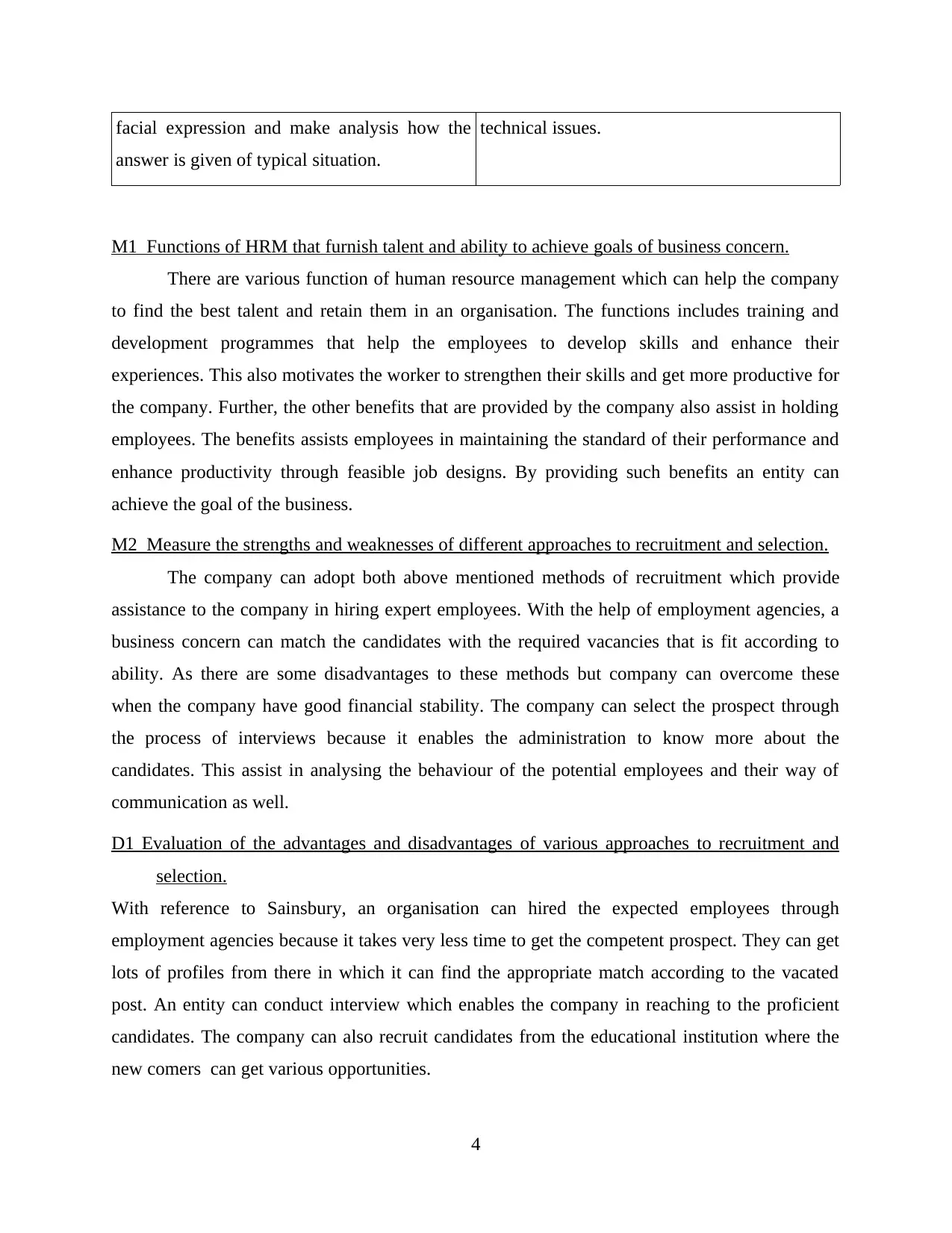
facial expression and make analysis how the
answer is given of typical situation.
technical issues.
M1 Functions of HRM that furnish talent and ability to achieve goals of business concern.
There are various function of human resource management which can help the company
to find the best talent and retain them in an organisation. The functions includes training and
development programmes that help the employees to develop skills and enhance their
experiences. This also motivates the worker to strengthen their skills and get more productive for
the company. Further, the other benefits that are provided by the company also assist in holding
employees. The benefits assists employees in maintaining the standard of their performance and
enhance productivity through feasible job designs. By providing such benefits an entity can
achieve the goal of the business.
M2 Measure the strengths and weaknesses of different approaches to recruitment and selection.
The company can adopt both above mentioned methods of recruitment which provide
assistance to the company in hiring expert employees. With the help of employment agencies, a
business concern can match the candidates with the required vacancies that is fit according to
ability. As there are some disadvantages to these methods but company can overcome these
when the company have good financial stability. The company can select the prospect through
the process of interviews because it enables the administration to know more about the
candidates. This assist in analysing the behaviour of the potential employees and their way of
communication as well.
D1 Evaluation of the advantages and disadvantages of various approaches to recruitment and
selection.
With reference to Sainsbury, an organisation can hired the expected employees through
employment agencies because it takes very less time to get the competent prospect. They can get
lots of profiles from there in which it can find the appropriate match according to the vacated
post. An entity can conduct interview which enables the company in reaching to the proficient
candidates. The company can also recruit candidates from the educational institution where the
new comers can get various opportunities.
4
answer is given of typical situation.
technical issues.
M1 Functions of HRM that furnish talent and ability to achieve goals of business concern.
There are various function of human resource management which can help the company
to find the best talent and retain them in an organisation. The functions includes training and
development programmes that help the employees to develop skills and enhance their
experiences. This also motivates the worker to strengthen their skills and get more productive for
the company. Further, the other benefits that are provided by the company also assist in holding
employees. The benefits assists employees in maintaining the standard of their performance and
enhance productivity through feasible job designs. By providing such benefits an entity can
achieve the goal of the business.
M2 Measure the strengths and weaknesses of different approaches to recruitment and selection.
The company can adopt both above mentioned methods of recruitment which provide
assistance to the company in hiring expert employees. With the help of employment agencies, a
business concern can match the candidates with the required vacancies that is fit according to
ability. As there are some disadvantages to these methods but company can overcome these
when the company have good financial stability. The company can select the prospect through
the process of interviews because it enables the administration to know more about the
candidates. This assist in analysing the behaviour of the potential employees and their way of
communication as well.
D1 Evaluation of the advantages and disadvantages of various approaches to recruitment and
selection.
With reference to Sainsbury, an organisation can hired the expected employees through
employment agencies because it takes very less time to get the competent prospect. They can get
lots of profiles from there in which it can find the appropriate match according to the vacated
post. An entity can conduct interview which enables the company in reaching to the proficient
candidates. The company can also recruit candidates from the educational institution where the
new comers can get various opportunities.
4
Paraphrase This Document
Need a fresh take? Get an instant paraphrase of this document with our AI Paraphraser
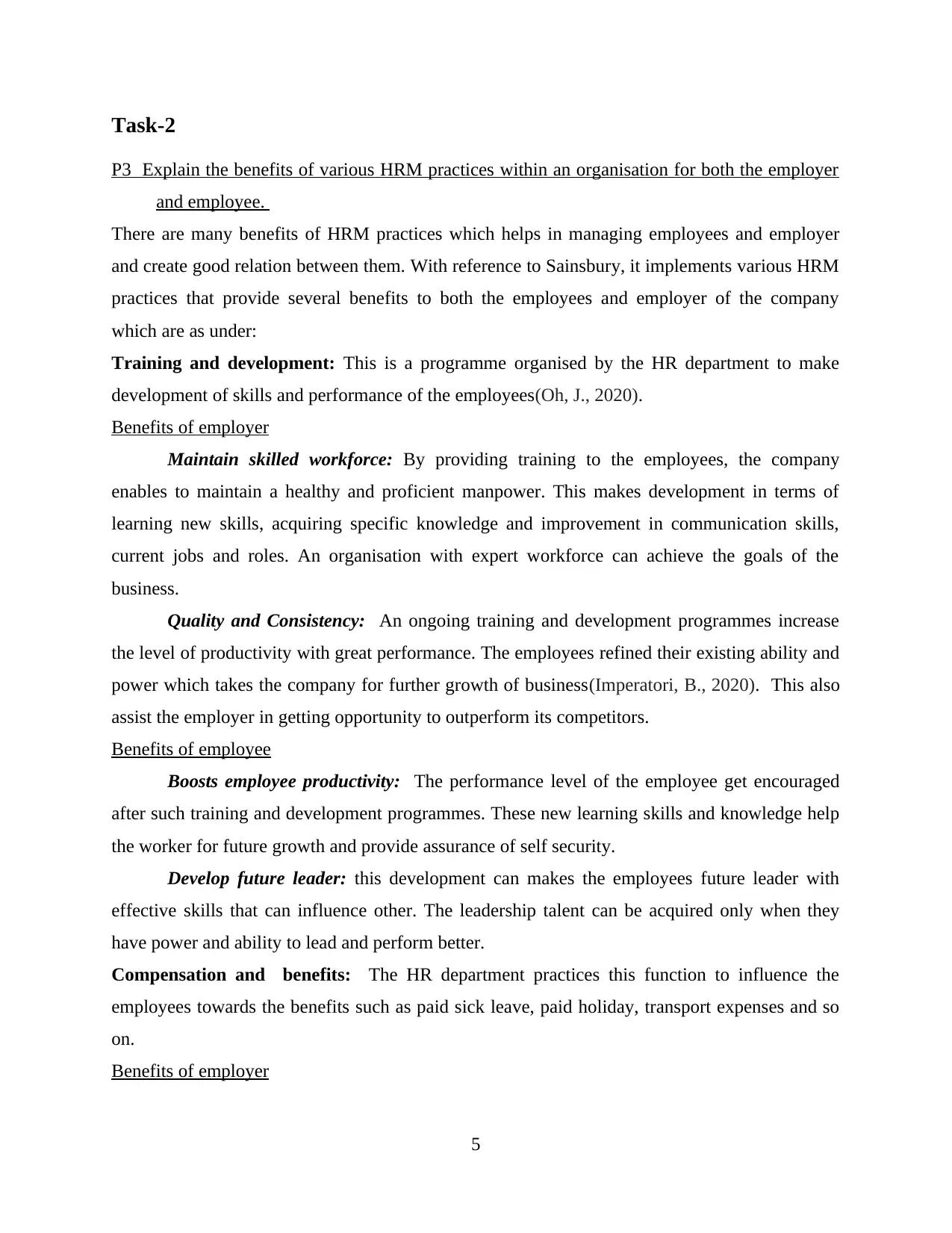
Task-2
P3 Explain the benefits of various HRM practices within an organisation for both the employer
and employee.
There are many benefits of HRM practices which helps in managing employees and employer
and create good relation between them. With reference to Sainsbury, it implements various HRM
practices that provide several benefits to both the employees and employer of the company
which are as under:
Training and development: This is a programme organised by the HR department to make
development of skills and performance of the employees(Oh, J., 2020).
Benefits of employer
Maintain skilled workforce: By providing training to the employees, the company
enables to maintain a healthy and proficient manpower. This makes development in terms of
learning new skills, acquiring specific knowledge and improvement in communication skills,
current jobs and roles. An organisation with expert workforce can achieve the goals of the
business.
Quality and Consistency: An ongoing training and development programmes increase
the level of productivity with great performance. The employees refined their existing ability and
power which takes the company for further growth of business(Imperatori, B., 2020). This also
assist the employer in getting opportunity to outperform its competitors.
Benefits of employee
Boosts employee productivity: The performance level of the employee get encouraged
after such training and development programmes. These new learning skills and knowledge help
the worker for future growth and provide assurance of self security.
Develop future leader: this development can makes the employees future leader with
effective skills that can influence other. The leadership talent can be acquired only when they
have power and ability to lead and perform better.
Compensation and benefits: The HR department practices this function to influence the
employees towards the benefits such as paid sick leave, paid holiday, transport expenses and so
on.
Benefits of employer
5
P3 Explain the benefits of various HRM practices within an organisation for both the employer
and employee.
There are many benefits of HRM practices which helps in managing employees and employer
and create good relation between them. With reference to Sainsbury, it implements various HRM
practices that provide several benefits to both the employees and employer of the company
which are as under:
Training and development: This is a programme organised by the HR department to make
development of skills and performance of the employees(Oh, J., 2020).
Benefits of employer
Maintain skilled workforce: By providing training to the employees, the company
enables to maintain a healthy and proficient manpower. This makes development in terms of
learning new skills, acquiring specific knowledge and improvement in communication skills,
current jobs and roles. An organisation with expert workforce can achieve the goals of the
business.
Quality and Consistency: An ongoing training and development programmes increase
the level of productivity with great performance. The employees refined their existing ability and
power which takes the company for further growth of business(Imperatori, B., 2020). This also
assist the employer in getting opportunity to outperform its competitors.
Benefits of employee
Boosts employee productivity: The performance level of the employee get encouraged
after such training and development programmes. These new learning skills and knowledge help
the worker for future growth and provide assurance of self security.
Develop future leader: this development can makes the employees future leader with
effective skills that can influence other. The leadership talent can be acquired only when they
have power and ability to lead and perform better.
Compensation and benefits: The HR department practices this function to influence the
employees towards the benefits such as paid sick leave, paid holiday, transport expenses and so
on.
Benefits of employer
5
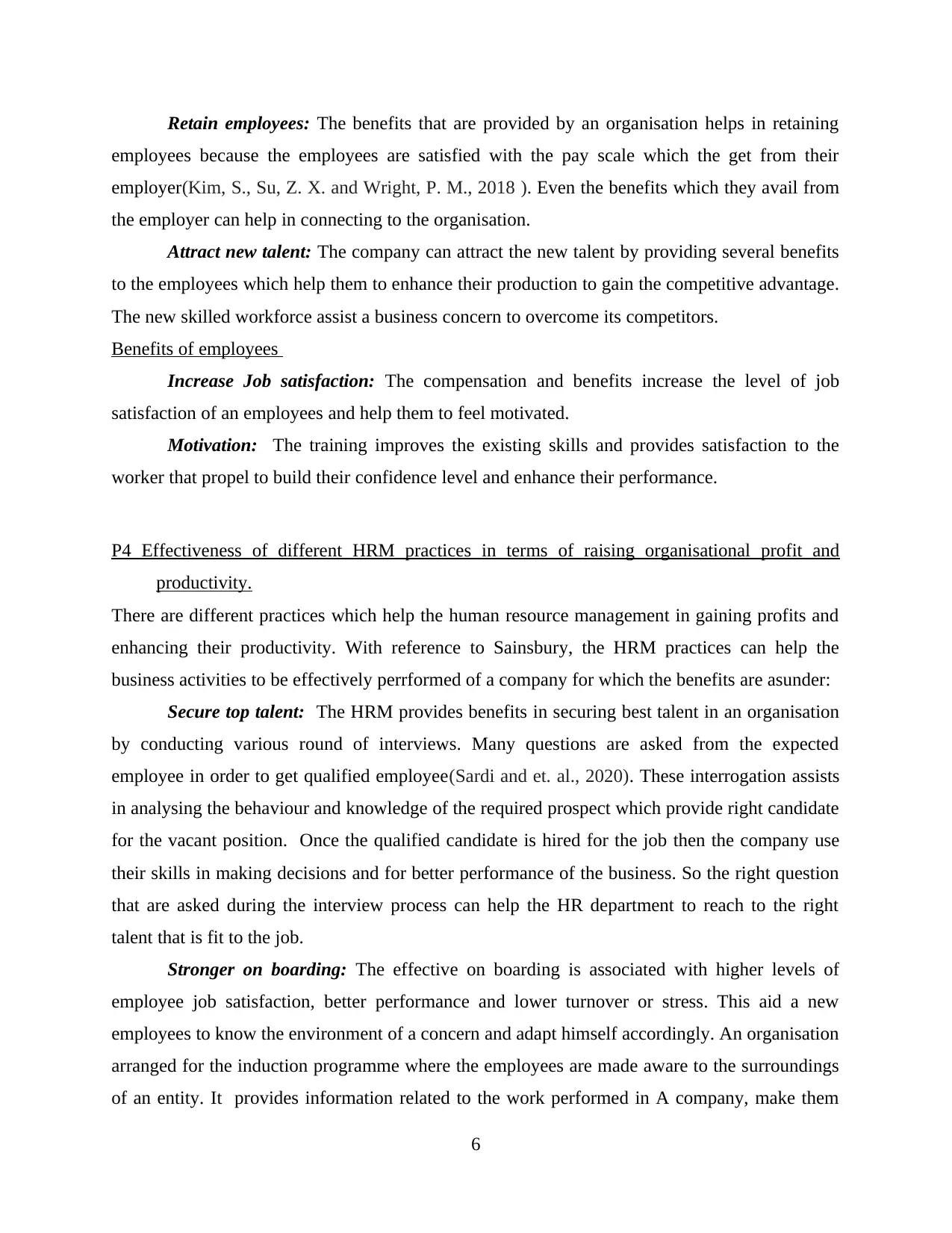
Retain employees: The benefits that are provided by an organisation helps in retaining
employees because the employees are satisfied with the pay scale which the get from their
employer(Kim, S., Su, Z. X. and Wright, P. M., 2018 ). Even the benefits which they avail from
the employer can help in connecting to the organisation.
Attract new talent: The company can attract the new talent by providing several benefits
to the employees which help them to enhance their production to gain the competitive advantage.
The new skilled workforce assist a business concern to overcome its competitors.
Benefits of employees
Increase Job satisfaction: The compensation and benefits increase the level of job
satisfaction of an employees and help them to feel motivated.
Motivation: The training improves the existing skills and provides satisfaction to the
worker that propel to build their confidence level and enhance their performance.
P4 Effectiveness of different HRM practices in terms of raising organisational profit and
productivity.
There are different practices which help the human resource management in gaining profits and
enhancing their productivity. With reference to Sainsbury, the HRM practices can help the
business activities to be effectively perrformed of a company for which the benefits are asunder:
Secure top talent: The HRM provides benefits in securing best talent in an organisation
by conducting various round of interviews. Many questions are asked from the expected
employee in order to get qualified employee(Sardi and et. al., 2020). These interrogation assists
in analysing the behaviour and knowledge of the required prospect which provide right candidate
for the vacant position. Once the qualified candidate is hired for the job then the company use
their skills in making decisions and for better performance of the business. So the right question
that are asked during the interview process can help the HR department to reach to the right
talent that is fit to the job.
Stronger on boarding: The effective on boarding is associated with higher levels of
employee job satisfaction, better performance and lower turnover or stress. This aid a new
employees to know the environment of a concern and adapt himself accordingly. An organisation
arranged for the induction programme where the employees are made aware to the surroundings
of an entity. It provides information related to the work performed in A company, make them
6
employees because the employees are satisfied with the pay scale which the get from their
employer(Kim, S., Su, Z. X. and Wright, P. M., 2018 ). Even the benefits which they avail from
the employer can help in connecting to the organisation.
Attract new talent: The company can attract the new talent by providing several benefits
to the employees which help them to enhance their production to gain the competitive advantage.
The new skilled workforce assist a business concern to overcome its competitors.
Benefits of employees
Increase Job satisfaction: The compensation and benefits increase the level of job
satisfaction of an employees and help them to feel motivated.
Motivation: The training improves the existing skills and provides satisfaction to the
worker that propel to build their confidence level and enhance their performance.
P4 Effectiveness of different HRM practices in terms of raising organisational profit and
productivity.
There are different practices which help the human resource management in gaining profits and
enhancing their productivity. With reference to Sainsbury, the HRM practices can help the
business activities to be effectively perrformed of a company for which the benefits are asunder:
Secure top talent: The HRM provides benefits in securing best talent in an organisation
by conducting various round of interviews. Many questions are asked from the expected
employee in order to get qualified employee(Sardi and et. al., 2020). These interrogation assists
in analysing the behaviour and knowledge of the required prospect which provide right candidate
for the vacant position. Once the qualified candidate is hired for the job then the company use
their skills in making decisions and for better performance of the business. So the right question
that are asked during the interview process can help the HR department to reach to the right
talent that is fit to the job.
Stronger on boarding: The effective on boarding is associated with higher levels of
employee job satisfaction, better performance and lower turnover or stress. This aid a new
employees to know the environment of a concern and adapt himself accordingly. An organisation
arranged for the induction programme where the employees are made aware to the surroundings
of an entity. It provides information related to the work performed in A company, make them
6
⊘ This is a preview!⊘
Do you want full access?
Subscribe today to unlock all pages.

Trusted by 1+ million students worldwide
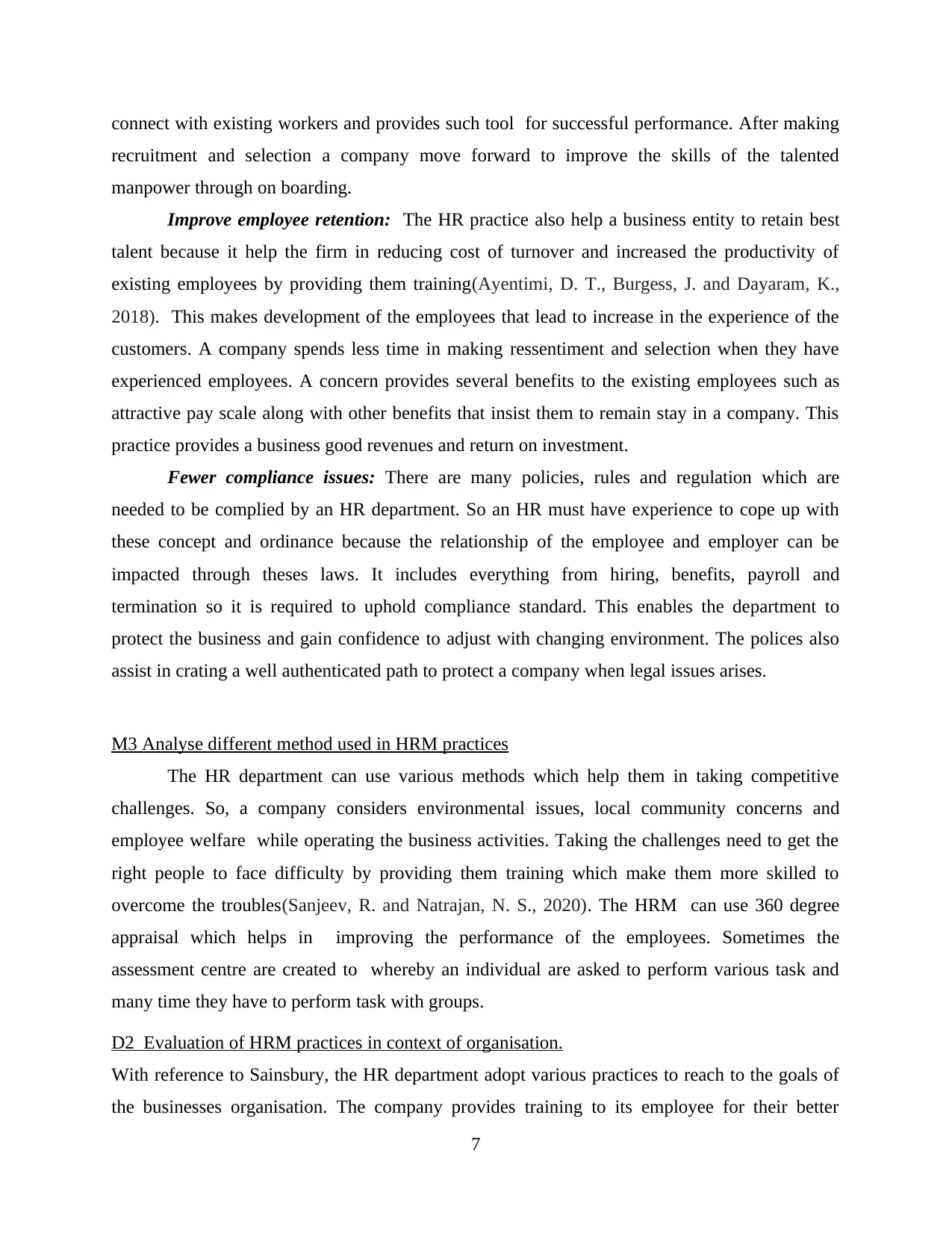
connect with existing workers and provides such tool for successful performance. After making
recruitment and selection a company move forward to improve the skills of the talented
manpower through on boarding.
Improve employee retention: The HR practice also help a business entity to retain best
talent because it help the firm in reducing cost of turnover and increased the productivity of
existing employees by providing them training(Ayentimi, D. T., Burgess, J. and Dayaram, K.,
2018). This makes development of the employees that lead to increase in the experience of the
customers. A company spends less time in making ressentiment and selection when they have
experienced employees. A concern provides several benefits to the existing employees such as
attractive pay scale along with other benefits that insist them to remain stay in a company. This
practice provides a business good revenues and return on investment.
Fewer compliance issues: There are many policies, rules and regulation which are
needed to be complied by an HR department. So an HR must have experience to cope up with
these concept and ordinance because the relationship of the employee and employer can be
impacted through theses laws. It includes everything from hiring, benefits, payroll and
termination so it is required to uphold compliance standard. This enables the department to
protect the business and gain confidence to adjust with changing environment. The polices also
assist in crating a well authenticated path to protect a company when legal issues arises.
M3 Analyse different method used in HRM practices
The HR department can use various methods which help them in taking competitive
challenges. So, a company considers environmental issues, local community concerns and
employee welfare while operating the business activities. Taking the challenges need to get the
right people to face difficulty by providing them training which make them more skilled to
overcome the troubles(Sanjeev, R. and Natrajan, N. S., 2020). The HRM can use 360 degree
appraisal which helps in improving the performance of the employees. Sometimes the
assessment centre are created to whereby an individual are asked to perform various task and
many time they have to perform task with groups.
D2 Evaluation of HRM practices in context of organisation.
With reference to Sainsbury, the HR department adopt various practices to reach to the goals of
the businesses organisation. The company provides training to its employee for their better
7
recruitment and selection a company move forward to improve the skills of the talented
manpower through on boarding.
Improve employee retention: The HR practice also help a business entity to retain best
talent because it help the firm in reducing cost of turnover and increased the productivity of
existing employees by providing them training(Ayentimi, D. T., Burgess, J. and Dayaram, K.,
2018). This makes development of the employees that lead to increase in the experience of the
customers. A company spends less time in making ressentiment and selection when they have
experienced employees. A concern provides several benefits to the existing employees such as
attractive pay scale along with other benefits that insist them to remain stay in a company. This
practice provides a business good revenues and return on investment.
Fewer compliance issues: There are many policies, rules and regulation which are
needed to be complied by an HR department. So an HR must have experience to cope up with
these concept and ordinance because the relationship of the employee and employer can be
impacted through theses laws. It includes everything from hiring, benefits, payroll and
termination so it is required to uphold compliance standard. This enables the department to
protect the business and gain confidence to adjust with changing environment. The polices also
assist in crating a well authenticated path to protect a company when legal issues arises.
M3 Analyse different method used in HRM practices
The HR department can use various methods which help them in taking competitive
challenges. So, a company considers environmental issues, local community concerns and
employee welfare while operating the business activities. Taking the challenges need to get the
right people to face difficulty by providing them training which make them more skilled to
overcome the troubles(Sanjeev, R. and Natrajan, N. S., 2020). The HRM can use 360 degree
appraisal which helps in improving the performance of the employees. Sometimes the
assessment centre are created to whereby an individual are asked to perform various task and
many time they have to perform task with groups.
D2 Evaluation of HRM practices in context of organisation.
With reference to Sainsbury, the HR department adopt various practices to reach to the goals of
the businesses organisation. The company provides training to its employee for their better
7
Paraphrase This Document
Need a fresh take? Get an instant paraphrase of this document with our AI Paraphraser
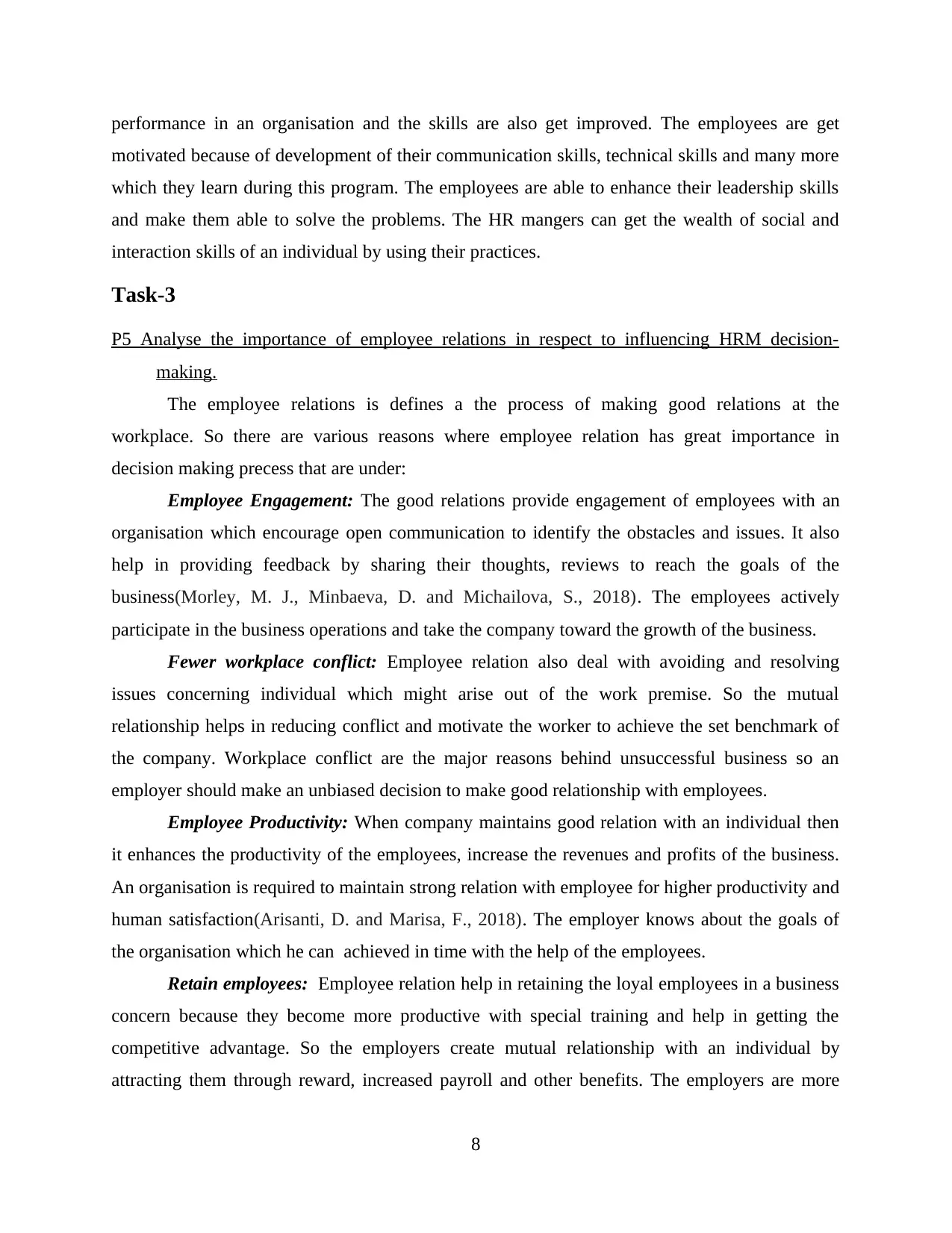
performance in an organisation and the skills are also get improved. The employees are get
motivated because of development of their communication skills, technical skills and many more
which they learn during this program. The employees are able to enhance their leadership skills
and make them able to solve the problems. The HR mangers can get the wealth of social and
interaction skills of an individual by using their practices.
Task-3
P5 Analyse the importance of employee relations in respect to influencing HRM decision-
making.
The employee relations is defines a the process of making good relations at the
workplace. So there are various reasons where employee relation has great importance in
decision making precess that are under:
Employee Engagement: The good relations provide engagement of employees with an
organisation which encourage open communication to identify the obstacles and issues. It also
help in providing feedback by sharing their thoughts, reviews to reach the goals of the
business(Morley, M. J., Minbaeva, D. and Michailova, S., 2018). The employees actively
participate in the business operations and take the company toward the growth of the business.
Fewer workplace conflict: Employee relation also deal with avoiding and resolving
issues concerning individual which might arise out of the work premise. So the mutual
relationship helps in reducing conflict and motivate the worker to achieve the set benchmark of
the company. Workplace conflict are the major reasons behind unsuccessful business so an
employer should make an unbiased decision to make good relationship with employees.
Employee Productivity: When company maintains good relation with an individual then
it enhances the productivity of the employees, increase the revenues and profits of the business.
An organisation is required to maintain strong relation with employee for higher productivity and
human satisfaction(Arisanti, D. and Marisa, F., 2018). The employer knows about the goals of
the organisation which he can achieved in time with the help of the employees.
Retain employees: Employee relation help in retaining the loyal employees in a business
concern because they become more productive with special training and help in getting the
competitive advantage. So the employers create mutual relationship with an individual by
attracting them through reward, increased payroll and other benefits. The employers are more
8
motivated because of development of their communication skills, technical skills and many more
which they learn during this program. The employees are able to enhance their leadership skills
and make them able to solve the problems. The HR mangers can get the wealth of social and
interaction skills of an individual by using their practices.
Task-3
P5 Analyse the importance of employee relations in respect to influencing HRM decision-
making.
The employee relations is defines a the process of making good relations at the
workplace. So there are various reasons where employee relation has great importance in
decision making precess that are under:
Employee Engagement: The good relations provide engagement of employees with an
organisation which encourage open communication to identify the obstacles and issues. It also
help in providing feedback by sharing their thoughts, reviews to reach the goals of the
business(Morley, M. J., Minbaeva, D. and Michailova, S., 2018). The employees actively
participate in the business operations and take the company toward the growth of the business.
Fewer workplace conflict: Employee relation also deal with avoiding and resolving
issues concerning individual which might arise out of the work premise. So the mutual
relationship helps in reducing conflict and motivate the worker to achieve the set benchmark of
the company. Workplace conflict are the major reasons behind unsuccessful business so an
employer should make an unbiased decision to make good relationship with employees.
Employee Productivity: When company maintains good relation with an individual then
it enhances the productivity of the employees, increase the revenues and profits of the business.
An organisation is required to maintain strong relation with employee for higher productivity and
human satisfaction(Arisanti, D. and Marisa, F., 2018). The employer knows about the goals of
the organisation which he can achieved in time with the help of the employees.
Retain employees: Employee relation help in retaining the loyal employees in a business
concern because they become more productive with special training and help in getting the
competitive advantage. So the employers create mutual relationship with an individual by
attracting them through reward, increased payroll and other benefits. The employers are more
8
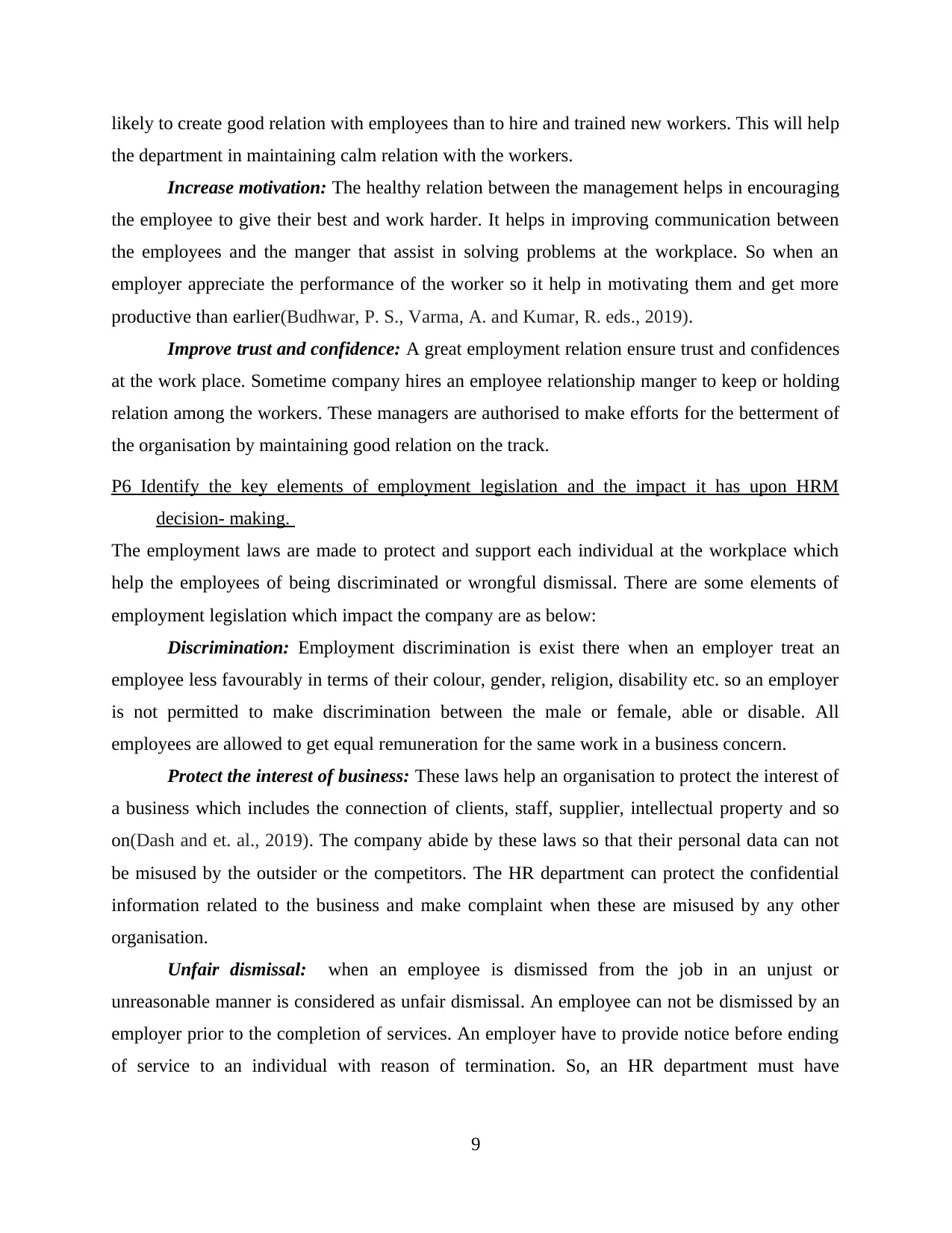
likely to create good relation with employees than to hire and trained new workers. This will help
the department in maintaining calm relation with the workers.
Increase motivation: The healthy relation between the management helps in encouraging
the employee to give their best and work harder. It helps in improving communication between
the employees and the manger that assist in solving problems at the workplace. So when an
employer appreciate the performance of the worker so it help in motivating them and get more
productive than earlier(Budhwar, P. S., Varma, A. and Kumar, R. eds., 2019).
Improve trust and confidence: A great employment relation ensure trust and confidences
at the work place. Sometime company hires an employee relationship manger to keep or holding
relation among the workers. These managers are authorised to make efforts for the betterment of
the organisation by maintaining good relation on the track.
P6 Identify the key elements of employment legislation and the impact it has upon HRM
decision- making.
The employment laws are made to protect and support each individual at the workplace which
help the employees of being discriminated or wrongful dismissal. There are some elements of
employment legislation which impact the company are as below:
Discrimination: Employment discrimination is exist there when an employer treat an
employee less favourably in terms of their colour, gender, religion, disability etc. so an employer
is not permitted to make discrimination between the male or female, able or disable. All
employees are allowed to get equal remuneration for the same work in a business concern.
Protect the interest of business: These laws help an organisation to protect the interest of
a business which includes the connection of clients, staff, supplier, intellectual property and so
on(Dash and et. al., 2019). The company abide by these laws so that their personal data can not
be misused by the outsider or the competitors. The HR department can protect the confidential
information related to the business and make complaint when these are misused by any other
organisation.
Unfair dismissal: when an employee is dismissed from the job in an unjust or
unreasonable manner is considered as unfair dismissal. An employee can not be dismissed by an
employer prior to the completion of services. An employer have to provide notice before ending
of service to an individual with reason of termination. So, an HR department must have
9
the department in maintaining calm relation with the workers.
Increase motivation: The healthy relation between the management helps in encouraging
the employee to give their best and work harder. It helps in improving communication between
the employees and the manger that assist in solving problems at the workplace. So when an
employer appreciate the performance of the worker so it help in motivating them and get more
productive than earlier(Budhwar, P. S., Varma, A. and Kumar, R. eds., 2019).
Improve trust and confidence: A great employment relation ensure trust and confidences
at the work place. Sometime company hires an employee relationship manger to keep or holding
relation among the workers. These managers are authorised to make efforts for the betterment of
the organisation by maintaining good relation on the track.
P6 Identify the key elements of employment legislation and the impact it has upon HRM
decision- making.
The employment laws are made to protect and support each individual at the workplace which
help the employees of being discriminated or wrongful dismissal. There are some elements of
employment legislation which impact the company are as below:
Discrimination: Employment discrimination is exist there when an employer treat an
employee less favourably in terms of their colour, gender, religion, disability etc. so an employer
is not permitted to make discrimination between the male or female, able or disable. All
employees are allowed to get equal remuneration for the same work in a business concern.
Protect the interest of business: These laws help an organisation to protect the interest of
a business which includes the connection of clients, staff, supplier, intellectual property and so
on(Dash and et. al., 2019). The company abide by these laws so that their personal data can not
be misused by the outsider or the competitors. The HR department can protect the confidential
information related to the business and make complaint when these are misused by any other
organisation.
Unfair dismissal: when an employee is dismissed from the job in an unjust or
unreasonable manner is considered as unfair dismissal. An employee can not be dismissed by an
employer prior to the completion of services. An employer have to provide notice before ending
of service to an individual with reason of termination. So, an HR department must have
9
⊘ This is a preview!⊘
Do you want full access?
Subscribe today to unlock all pages.

Trusted by 1+ million students worldwide
1 out of 19
Related Documents
Your All-in-One AI-Powered Toolkit for Academic Success.
+13062052269
info@desklib.com
Available 24*7 on WhatsApp / Email
![[object Object]](/_next/static/media/star-bottom.7253800d.svg)
Unlock your academic potential
Copyright © 2020–2025 A2Z Services. All Rights Reserved. Developed and managed by ZUCOL.





